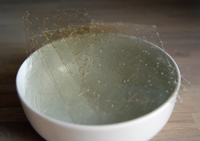
Photo from wikipedia
An electronic "smart" contact lens device with high gas permeability and optical transparency, as well as mechanical compliance and robustness, offers daily wear capability in eye interfacing and can have… Click to show full abstract
An electronic "smart" contact lens device with high gas permeability and optical transparency, as well as mechanical compliance and robustness, offers daily wear capability in eye interfacing and can have broad applications ranging from ocular diagnosis to augmented reality. Most existing contact lens electronics utilize gas-impermeable substrates, electronic components, and interfacial adhesion layers, which impedes them from applications requiring continuous daily wear. Here we report on the design and fabrication of an eye interfacing device with a commercial ocular contact lens as the substrate, metal-coated nanofiber mesh as the conductor, and in situ electrochemically deposited poly(3,4-ethylenedioxythiophene) (PEDOT) /poly(styrene sulfonate) (PSS) as the adhesion material. This hydrogel contact lens device shows high gas permeability, wettability, and level of hydration, in addition to excellent optical transparency, mechanical compliance, and robustness. Using a rabbit model, we found that the animals wearing these hydrogel contact lens devices continuously for 12 hours showed a level of corneal fluorescein staining comparable to those wearing pure hydrogel contact lenses for same period of time, with no obvious corneal abrasion or irritation, indicating their high level of safety for continuous daily wear. Finally, full-field electroretinogram (ERG) recordings on rabbits were carried out to demonstrate the functionality of this device. We believe that the strategy of integrating nanofiber mesh-based electronic components demonstrated here can offer a general platform for hydrogel electronics with the advantages of preserving the physiological and mechanical properties of the hydrogel, thus enabling seamless integration with biological tissues and providing various wearable or implantable sensors with improved biocompatibility for health monitoring or medical treatment.
Journal Title: ACS nano
Year Published: 2019
Link to full text (if available)
Share on Social Media: Sign Up to like & get
recommendations!